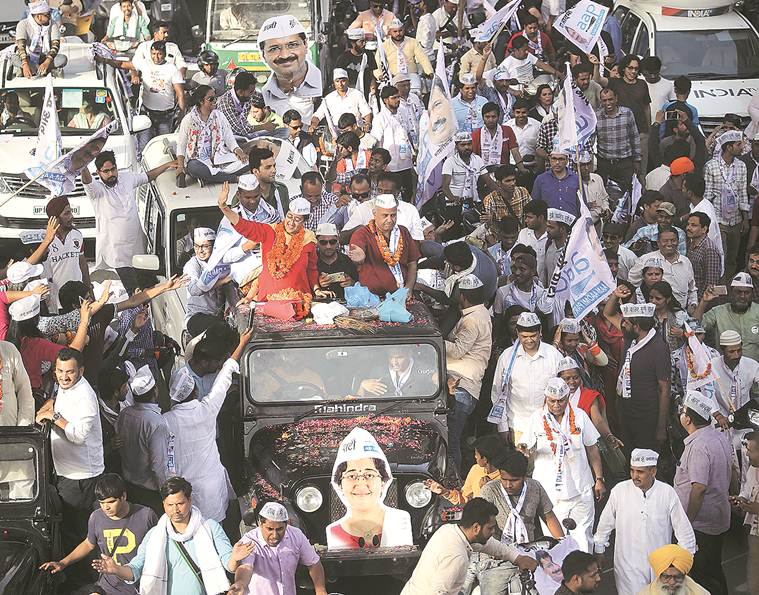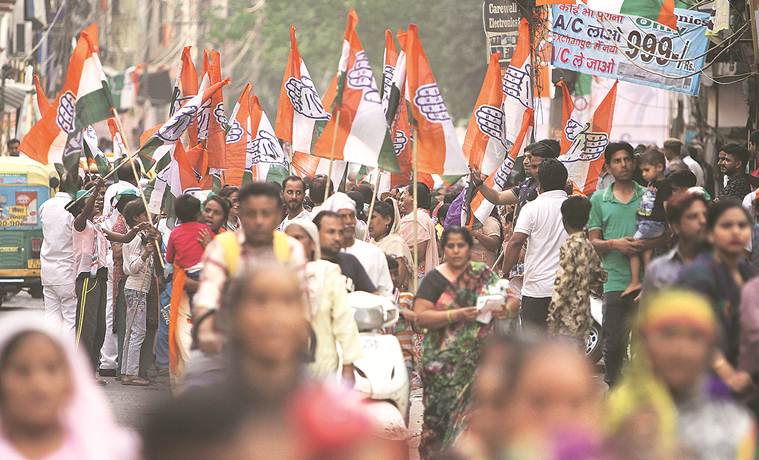
Bharatiya Janata Party
The BJP’s win, office bearers said, is inextricably tied to the enthusiasm of its booth-level workers. A day after the win, it was these workers who flocked to the party office in small batches to celebrate. And given the months of toiling, celebrations were long overdue.
In the run-up to the polls, the BJP appointed presidents to 13,000 booths out of 13,816 in the city. It then went hyper local by appointing panna pramukhs, which means one person being given charge of a page in the electoral roll that had names of 8-10 families. “We also appointed panch parmeshwars… essentially five people in charge of all the booths,” Delhi BJP general secretary Rajesh Bhatia said.
An RSS model of campaigning, the strategy to appoint panna pramukhs has yielded results for the BJP in several elections in the past.
Bhatia said that while choosing booth in-charges or panch parmeshwars, the caste and regional break-up of the locality was kept in mind. “If it was a slum, the booth in-charge would have to be from the area. For a posh colony, someone like the RWA head would be picked,” he said.
After candidates were announced, the party focussed on reaching out to workers as they knew this was the only way to connect with the masses.
BJP Delhi in-charge Shyam Jaju said, “Some of our candidates’ names were announced a day before the nomination. We told them to focus on workers, and the workers will focus on people.” The candidates asked all civic body councillors to focus on their wards, and district presidents on their districts, he said.
Delhi Lok Sabha co-in charge Jaibhan Singh Pawaiya said that during the last election, conversation was centred around issues such as corruption under the Congress regime and price rise, but this time, party workers were told to reach out to beneficiaries of central schemes. “At the local level, councillors have a personal connect with people in their area, they know who has benefited from central schemes like Ujjwala, Skill India, Mudra loan,” he said.
The BJP then decided to launch campaigns such as ‘Ujjwala Chai Pe Charcha’ and ‘Kamal Mehendi’, through which workers could reach out to beneficiaries directly.
The other strategy was to bring local AAP and Congress leaders into its fold. Delhi BJP president Manoj Tiwari said, “When you bring in smaller leaders at the ward or district level, it doesn’t make headlines, but on the ground it means thousands of votes drifting.”
However, the party still feared sealing and GST could dent its popularity among traders.
To counter this, Union Minister Vijay Goel organised an event where the PM would address traders. “I first went to meet traders in sealing affected areas individually and told them that it is certain the BJP is coming to power. They have their share of grievances but it can only be sorted if they give us power in Delhi as well… and they need to choose BJP candidates as MPs so he or she can raise this issue in Parliament,” Goel said.
Aam Aadmi Party

In April, when AAP announced its campaign strategy, the idea was to assign 10 vijay pramukhs in each booth, along the lines of BJP’s panna pramukh strategy. But among the key feedback that the party got this time was that no one reached out to them.
According to multiple party insiders and volunteers, the erosion in booth-level workers’ base began in 2017, during the MCD polls, where AAP faced a rout.
They pointed out that the party had “alienated” a large number of volunteers who played a key role in scripting the success story of 2015, when AAP nearly wiped out the Opposition and came to power in Delhi with 67 seats in the 70-member Assembly.
“In 2017, volunteers who were active two years ago were sidelined for some reason and new faces were brought in. The 2019 polls saw a repeat of that mistake. Many workers holding important posts at the local level switched over to the BJP. The West Delhi youth wing president went to the BJP before the polls and worked for Parvesh Sahib Singh, who won from West Delhi,” said a volunteer on condition of anonymity.
“Booth-level presence was our strength, but the BJP took the edge this time. In fact, even local MLAs were not given much importance. The leadership did not trust them at all. The Congress and BJP pay its volunteers, AAP doesn’t. But youth have so far flocked to AAP, attracted by a sense of idealism, even at the cost of losing jobs or suffering pay cuts,” the volunteer said.
Another volunteer who actively campaigned this time said the leadership’s fallout with poet Kumar Vishwas, one of the founding members of AAP, also drove away a large number of ground-level workers.
“Several youth rallied around Vishwas. The general view is that if the leadership can settle cases with the likes of Arun Jaitley and Bikram Singh Majithia, why can’t they extend an olive branch to Vishwas,” the functionary said.
The rift between Vishwas and AAP chief Arvind Kejriwal had widened over nomination of two outsiders — businessman Sushil Gupta and chartered accountant N D Gupta — to the Rajya Sabha.
“We were told Sushil Gupta’s induction was aimed at expanding the party’s base in Haryana. But what did we really achieve? How many votes did our candidates poll there? These are questions the leadership should address,” he said.
AAP used to have in-charges of polling stations, which have multiple booths under them.
Volunteers told The Indian Express that the posts had been “diluted” by appointing more than one person, with different designations, at the level of booths. “This really didn’t help. The multiplicity of power centres at the micro level was bound to fail,” one volunteer said.
They also pointed out that the issue of full statehood — the pivot of the party’s campaign — was perceived as a “deception” even by supporters. “People are not fools. They know full statehood is not that easy, and certainly not possible with a few MPs. Not everyone may be aware of the Constitutional provisions, but this much they know,” a party leader said.
Another voice of dissent came from Arvind Jha, who has been the AAP’s IT and social media head. He said the party should internalise the “message” sent by voters that it should not try to become “yet another political party”.
The “turning point”, Jha said, came after the Centre took over the Anti-Corruption Branch. The resultant “anger and frustration changed Kejriwal” and shifted him from his “anti-politician mission” to “revenge against Modi”.
“In this new mission, he was ready to accept compromises, tactics, strategies and abandon his core principles just to see Modi defeated,” Jha, who has handled the party’s finances in the past, wrote in a blog.
The AAP used to carry a list of donors on its website, but later took it down claiming Central agencies were going after them. Jha claimed he tried multiple times to put up a new list that protects the donors while retaining the benefits of being transparent, only to be turned down by the party. He further alleged that in terms of candidate selection, “winnability at all costs overrode alignment to ideology and honest politics”.
And Kejriwal’s parleys with opposition leaders “to bolster his image as a national leader” was the final nail in the coffin, he wrote.
Congress

From organising booth-level conventions to getting the old guard on the same page, the Congress was fighting not just to win, but to stay relevant in the capital.
Senior leaders working closely with the party said the improved vote share that helped the party finish second ahead of AAP was largely because of candidate selection — from Sheila Dikshit and Ajay Maken to Arvinder Singh Lovely and J P Agarwal. “Sheila ji’s positive image helped… During her tenure (as CM), the capital went through phenomenal change…. Of course, other leaders played a role, but this was the game changer,” said Subash Chopra, Delhi Congress’s campaign committee chairman.
Lovely, who finished second in East Delhi, ahead of AAP’s Atishi, said: “All groups in the city were accommodated while selecting candidates. And people were upset with Kejriwal and knew only the Congress can give a fight to the BJP. In my case, workers went a step ahead by talking about AAP’s failure and Congress’s work.”
Here, too, the party relied heavily on its cadre to take the message to the people. To encourage workers, party president Rahul Gandhi addressed a booth-level convention. The state unit, under Maken’s leadership, also arranged similar conventions across the capital. According to one leader, “dynamic and important” persons of the area were included in the committee, and the party appointed booth sahyogis to understand what people expected.
“These workers went door-to-door to understand issues at the ground level. Booth presidents along with area coordinators were appointed to scrutinise information gathered by the 150-200 lok sahayogis to strengthen the party apparatus at the booth level. We had committees at every level — district, block Congress and booth. All these helped us in these elections,” said senior Congress leader Mateen Ahmed.
For the 13,816 booths in the capital, the party appointed 8,000 members. Every booth had 10 members and an in-charge. These workers also went to residents to explain the Congress’s NYAY’s scheme, though Dikshit later told The Indian Express that the message could have been communicated better.
“We also went from one household to another, talking about Delhi’s development and how the city was stuck in the fighting between AAP and BJP,” said a party worker.